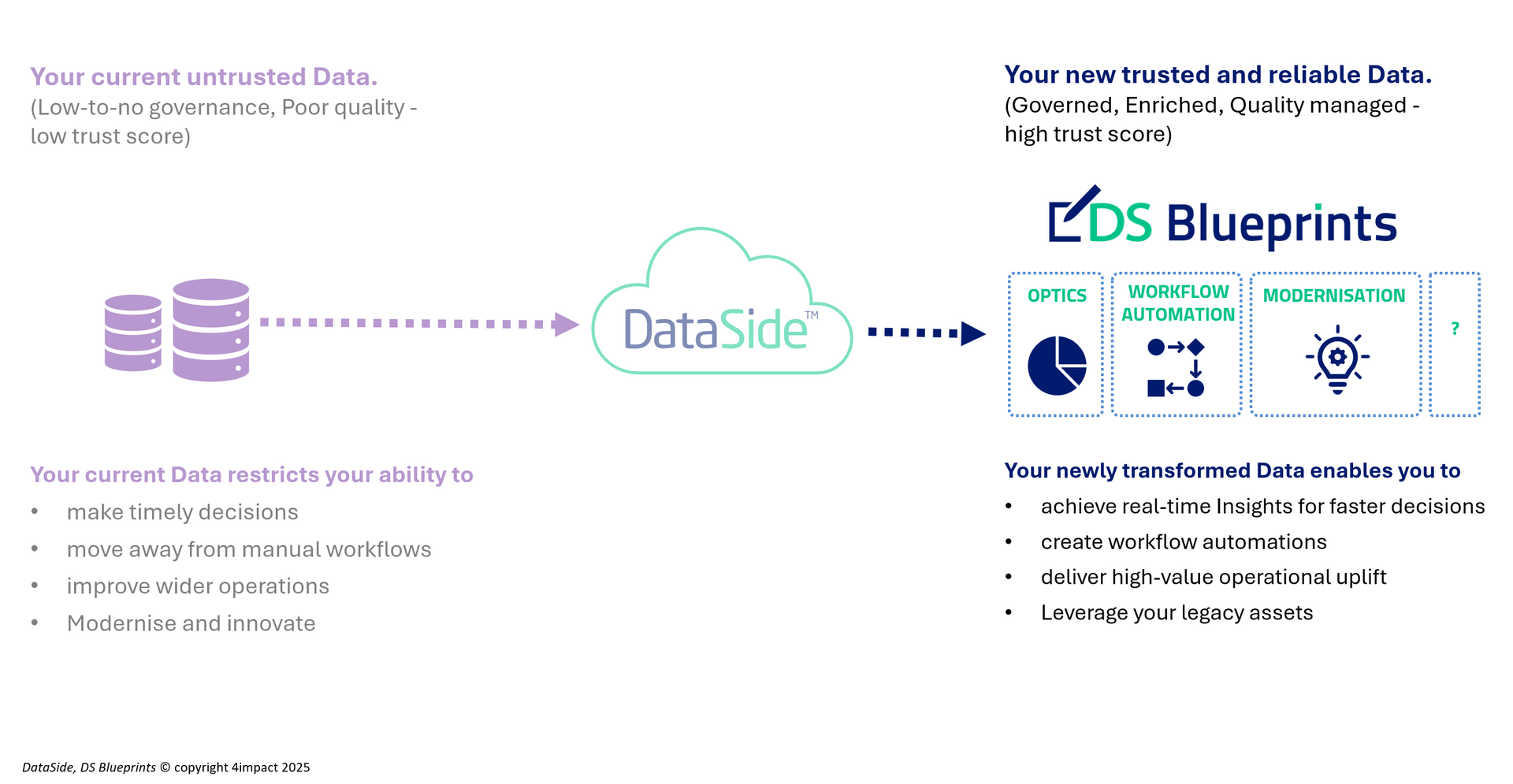DS Blueprints
enable ‘quick-wins’ whilst unlocking real-time reporting, workflow automations and more.
DS Blueprints™ leverages DataSide™ to enable ROI-driven ‘quick-wins’ as well as provide the paths for medium to long term uplift.

Top level overview video: DataSide and DS Blueprints

OPTICS
Visibility, Reporting, Security, Risk & Compliance
Generate real-time reporting insights you can trust to accelerate your time-to-decisions.
Optics delivers timely, actionable visibility through real-time dashboards, consolidated reporting, and a trusted source of truth.
It embeds security, risk, and compliance into reporting to support regulatory and governance needs.
Best used when
- Leaders need reliable, current data to guide decisions.
- Compliance reporting or audits are slow or error-prone.
- Data from multiple systems must be unified.
- Risk and security insights need visibility.
Problems it solves
- Inaccessible or outdated performance data.
- Manual, inefficient reporting processes.
- Conflicting reports causing decision delays.
- Difficulty meeting compliance and reporting standards.
- Poor visibility into risk and security posture.

WORKFLOW AUTOMATION
Deploy workflow automations that leverage triggers based on your real-time data.
Workflow Automation is about streamlining business processes to improve efficiency, reduce errors, and accelerate delivery.
It focuses on
eliminating manual, repetitive work and enhancing the seamless flow of information and tasks across systems and teams.
Best used when
- Manual or repetitive tasks slow down operations or introduce errors.
- Integration between different business systems is lacking, resulting in data silos or workflow bottlenecks.
- Scaling operations without proportional increases in headcount is a priority.
- Inefficient workflows are impacting customer service, internal productivity, or compliance.
Problems it solves
- High operational costs from manual, repetitive tasks.
- Errors and delays from disconnected systems.
- Slow service due to inefficient workflows.
- Inconsistent data across applications.
- Scaling issues as business grows.
- Low staff satisfaction from tedious work.
- Compliance and reporting challenges from manual processes.

MODERNISATION
Transform legacy systems to reduce technical debt whist increasing efficiencies.
Modernisation focuses on transforming legacy systems, including re-platforming or replacing monolithic applications, and supporting merger & acquisition integration.
This blueprint is about
increasing agility, reducing technical debt, and ensuring systems are fit for future business needs.
Best used when
- Legacy systems are costly to maintain or hinder business agility.
- During or following mergers or acquisitions that require system integration or transformation.
- Existing systems lack scalability, security, or support for new business models.
- Technical debt is limiting innovation or operational efficiency.
Problems it solves
- High costs and risks from legacy systems.
- Trouble integrating new apps with old infrastructure.
- System misalignment post-mergers or acquisitions.
- Limited scalability for new initiatives.
- Security and compliance gaps in legacy tech.
- Slow market response from rigid systems.
- Hard to attract talent for outdated stacks.

ANALYTICS
Generate insights and forecast trends by leverage historical and real-time data.
Analytics leverages historical and real-time data to generate insights, forecast trends, and support data-driven decision-making.
Predictive analytics
uses statistical models and machine learning to anticipate future outcomes and guide strategy.
Best used when
- When anticipating customer behaviour or market trends is critical.
- If early warning of risks or opportunities would drive better decisions.
- Where large volumes of data are available but underutilised.
- When the business wants to shift from descriptive to predictive and prescriptive insights.
Problems it solves
- Inability to forecast demand, sales, or operational risks.
- Missed opportunities due to lack of insight into customer trends or market changes.
- Difficulty identifying and mitigating emerging risks in advance.
- Underutilisation of data for strategic planning and competitive advantage.
- Challenges in personalising customer engagement or improving retention.

INNOVATION
New technologies supported by creative approaches unlock new business value.
Innovation is about leveraging new technologies and creative approaches to unlock new value, differentiate from competitors, and future-proof the business.
This may involve
piloting AI, experimenting with new business models, or fostering a culture of experimentation and rapid learning.
Best used when
- When the business wants to stay ahead of industry trends or disrupt the market.
- If there’s a need to solve complex problems in new ways.
- When fostering a culture of continuous improvement and learning is a strategic goal.
- Where technology can open up new products, services, or revenue streams.
Problems it solves
- Lack of differentiation in a competitive market.
- Slow adoption of emerging technologies and digital trends.
- Difficulty identifying or capitalizing on new business opportunities.
- Siloed or stagnant culture resistant to change.
- Inability to rapidly test and scale new ideas or solutions.

OPTIMISATION
Advanced algorithms supported by a data-driven approach to deliver uplift and reduced costs.
Optimisation uses data-driven approaches and advanced algorithms to improve efficiency, reduce costs, and maximise resource utilisation.
It’s about
identifying bottlenecks, balancing constraints, and continuously improving processes for better business outcomes.
Best used when
- When there are complex operations or logistics that could benefit from optimisation (e.g., routing, scheduling, inventory).
- If cost reduction or efficiency gains are key business drivers.
- Where there is a need to make better use of existing resources.
- When there’s a desire to move from reactive to proactive operational management.
Problems it solves
- High operational costs or resource wastage.
- Inefficient routing, scheduling, or allocation of resources.
- Bottlenecks or constraints limiting throughput or service levels.
- Difficulty balancing competing objectives (e.g., cost vs. speed vs. quality).
- Lack of insight into which process improvements would yield the best ROI.
Let's talk about what
DS Blueprints
could mean for your reporting, workflows and operations.
DS Blueprints business enhancements
Thank you for reaching out to DataSide.
We'll be in touch asap, though please allow 1-2 business days.
In the meantime check out our official integration partner Sida4.io
Oops, there was an error sending your message.
Please try again later.

